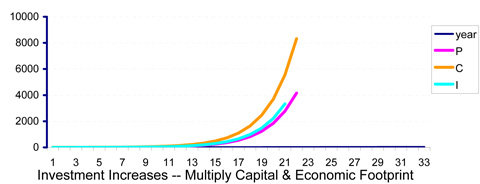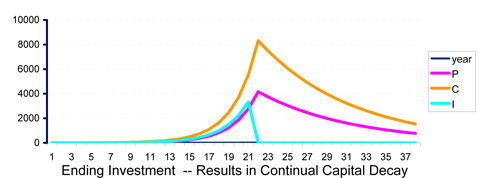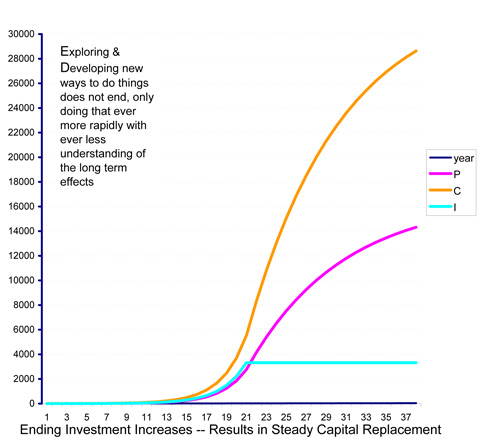A simple model
of Keynes' Proposal for stable Economic Climax
Naturally
Stabilizing Economies by Ending
Compound Investment (for profitability)
J L Henshaw
id @ synapse9.com
09/16/07 05/21/08 08/26/08 6/19/12
More discussion of the theory from a
natural systems perspective is at NaturalClime.htm
and
searching the site and my blog for mentions of Keynes.
This page introduces a simple spreadsheet model showing the effect.
The automatic compounding of investment income ends to allow the physical
processes of economies to switch from expanding to maturing, and distributing
wealth thereby too. Real sustainable development is more complicated, but as a
financial choice it amounts to a single simple policy decision to preserve
capital by turning off the "multiplier". Otherwise the multiplier is only
turned off when investments or returns themselves collapse. The
general idea was first proposed by economist J. M. Keynes saying:
"may
be the most sensible way of gradually getting rid of many of the objectionable
features of capitalism" (General Theory, Ch 16)
It was then promoted for decades by visionary economist Kenneth Boulding,
which I discovered when working on it in the early 1980's.
This version focuses on the simplest rule that would end the
compounding of returns, voluntary spending by investment owners.
That would keep economies from falling into global credit traps, as so prevalent
in the long history of economic disasters. To keep economies
profitable in the long term investors would need to spend their profits in the
interest of maximizing the profitability of the environment they are profitinb
from, i.e. as an endowment for sustainability.
---
The short statement:
Economies grow because surpluses are reserved for expanding them.
Growth in a market economy is managed by allocating funds from a savings pool to
generate returns, and
those returns then added to the pool to increase the total amounts invested.
It increases the investments and the returns exponentially, by adding positive
%'s of the prior total. The end for that comes at a pont of
"over-investment" when increasing investment becomes less and less
profitable. Then, as the whole falils to prosper, investors still
seeking maximum growth for themselves do so as the expense of everyone else,
rather than as before to the benefit of everyone else.
Seeing diminishing returns for the whole approaching, a choice
could be made to
prevent a terminal decline in the profitability of the whole, by a collective
choice to end the general compounding of returns, as socially discredited.
One practical way would be to distinguish between earned and unearned income,
encouraging people to save from earned income, but prevent the saving of
returns on investment (unearned income). Then investors would need to
spend their unearned income on purposes serving other values.
It's
not important here to discuss all the reasons our
economy developed a plan to grow ever faster forever. It's only
important to note that literally all kinds of systems in nature initially
develop with a growth process, whatever their natural beginning or end.
It's essentially a law of physics, that nothing can start at it's full size, but
due to the conservatin of energy needs to begin with the kind of non-linear
development we call growth.
No
doubt ending economic growth would be a big adjustment, but it need not mean slowing
things down, except as people realize slowing down a bit might be a more
profitable way to go. It just means removing the steering principles
that result in automatic maximum rates of expansion, and guiding investors to
invest so the system as a whole remains profitable.
Nature
demonstrates this investment strategy as growth slows down at the point where
organisms or other systems begin to mature. At that time their
self-investment goes stabilizing at a peak of vitality and maximizing their
ability to interact with their environment. It's a process of
turning from inward to outward interests, like students perfecting their
development as they complete school so they can become independent actors in the
world. So turning the use of the investment profits from internal to
external growth is a way
to copy
nature's method.
The cybernetic steering
principle is for the viewpoint of cells that have doubling to grow their body,
as it begins to become taxing rathre than enriching, turn you attention to
perfecting other things. It's the standard investment principle of
family businesses, in which people work very hard to make it grow till it can
support their true interests in having a business.
The graphs are of a very simple but very natural economic
"through-put" model from an Excel spreadsheet,
using the variables: Investment, Capital, Products and Returns on Investment (1):
1) Investment funds build Capital goods
2) Capital goods build Products
3) Capital
goods and Products
both decay over time
4) Investment
funds produce Returns and do not decay
5) Returns
are added to Investment
funds at first
6) So Investments, Capital
and Products first multiply and then stabilize
After year 20 in the model, to keep it simple, either
investment is stopped or compounding the returns is stopped, causing a developmental turning point. These
demonstrate the control potential for these two types of 'intervention', one
destructive and the other constructive.
What Keynes noticed was that as complications of growth set in, if the constructive choice was not made
the destructive one would happen.
 |
A. In limitless economic growth, investment builds capital goods, and
capital goods build products. Returns of a small %
then adds to investment, and this forms a continually multiplying spiral of
expansion as long as resources of ever greater amounts and ever lower costs keep
being found too. |
 |
B. If investment were suddenly ended, capital goods would decay with some
parts wasting away more quickly than others, and everything would wind down.
It's hard to imagine a choice people could make to end investment permanently.
It's easier to imagine how a gereral financial collapse might result in economic
breakdown and decay. The reality is that most complex societies in
history seem to have done something of the sort, and vanished without
leaving a record what the self-created problem they faced was, like
Rome, the Mayans, Easter Islanders. |
 |
C.
Ending the compounding of investment would be an actually quite small
change in the economy, having a quite large accumulative effect. Here only the increment
by which investment is increased each year is restricted. The
behavior switches from a run-away explosion to
seeking a self-defined natural balance.
This represents transformative cybernetic control. It is a large
conceptual leap to imagine, but satisfies the necessity that we somehow end our
exploding economic footprint on the earth. It does so without disrupting
the physical economy of the time except to alter its rate of change.
What most people don't realize is that this is the growth sequence of their own
original biological growth and development. We all started from a short
period of exponential expansion (starting from a single fertilized cell).
That 'immature' explosive growth was followed by switching to maturation and
leading to our independence in the world. Maturation is the step to
independence. That's actually the normal development sequence for
all living things, and an option that is available for economies. If you
consider the time scale in the charts to be hundreds of years, give or take,
this might also suggest the general time scale over which this kind of change
might take effect, starting growth for a short period and maturing growth for a
long period. |
notes:
(1) definitions of the variables and the model and a few notes are to be
found in
GrowthSwitch.xls It's a series of 3 simultaneous relationships, Economic
Product: P1=C0*R, Capital: C1=C0-C0*d+I0
and Investment: I1=I0+I0*r.
Run 2 makes I0=0 at step 20, and run 3 makes r=0 at
step 20. That's the entire difference. Many more features
could be added, but the result is the same if, as here, 'r' includes all
the regularly reinvested returns on investment and setting it to zero has no
other effect on how returns on investment are used.


